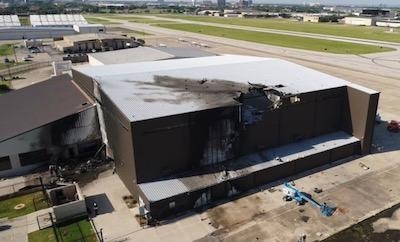Ten People Were Fatally Injured When The Airplane Impacted A Hangar At The Airport
The NTSB has released its preliminary report from an accident which occurred June 30 in Addison, TX that resulted in the fatal injury of two pilots and eight passengers aboard a Beechcraft King Air 300.

According to the report, the aircraft was departing Addison Airport (KADS) en route to Albert Whitted Airport (KSPG), in St. Petersburg, FL. Visual meteorological conditions prevailed, and an IFR flight plan had been filed for the flight.
The airplane was registered to EE Operations LLC. According to information provided by EE Operations and Flyte Aero (an aviation services provider), the flight crew, and passengers arrived at the airport to prepare for the personal flight, about an hour and a half prior to the accident. The airplane fuel tanks were "topped off" and luggage was loaded in the aft baggage compartment of the airplane.
According to FAA air traffic control data, the pilot contacted ground control stating he was ready to taxi and about 0905 was provided taxi instructions to runway 15. About 0910 the pilot was given departure instructions to turn left heading 050 and was cleared for takeoff from runway 15.
The takeoff and departure of the airplane was captured by radar and multiple security cameras and was observed by several witnesses located in various locations at the airport. One witness stated that as the airplane went down the runway, it seemed more quiet than normal and sounded like it did not have sufficient power to takeoff. After the airplane lifted off, witnesses observed the airplane drift to the left, and then roll to the left before colliding with the hangar. Several security cameras captured the drift to the left immediately after takeoff and then a roll to the left. One camera showed the airplane roll completely inverted before it collided with the hangar.
Witness marks and wreckage distribution were consistent with the airplane impacting the top of the hangar in a right wing low, nose down, and inverted attitude. The empennage, right engine, and both propeller assemblies separated from the airplane during the impact sequence and were located inside of the hangar. Fragmented pieces of both wings were located on top of the hangar, inside of the hangar, and immediately to the north of the hangar. The main wreckage, which included the left engine and the fuselage, was located outside of the hangar and it came to rest adjacent to a brick wall. The main wreckage came to rest on its right side and was destroyed by the impact forces and postimpact fire.
The airplane was equipped with an L3 FA2100 cockpit voice recorder (CVR). The CVR recorded 2 hours of high-quality audio including the accident flight. A crew comment regarding a problem with the left engine occurred about 8 seconds before the end of the recording. Three automated "bank angle" aural alerts began about 3 seconds before the end of the recording. A CVR group comprised of technical experts will convene at NTSB headquarters in Washington, DC, to review the entire accident recording, and produce a written transcript.
Several avionics components and personal electronic devices were recovered from the wreckage. These components and devices were secured for further examination. Both engine assemblies were recovered from the wreckage and were secured for further examination.
(Image provided with NTSB preliminary report)
 ANN's Daily Aero-Term (05.01.24): Say Altitude
ANN's Daily Aero-Term (05.01.24): Say Altitude ANN's Daily Aero-Linx (05.01.24)
ANN's Daily Aero-Linx (05.01.24) Classic Aero-TV: Korean War Hero Twice Reborn
Classic Aero-TV: Korean War Hero Twice Reborn Airborne 04.29.24: EAA B-25 Rides, Textron 2024, G700 Deliveries
Airborne 04.29.24: EAA B-25 Rides, Textron 2024, G700 Deliveries Airborne Affordable Flyers 05.02.24: Bobby Bailey, SPRG Report Cards, Skydive!
Airborne Affordable Flyers 05.02.24: Bobby Bailey, SPRG Report Cards, Skydive!



